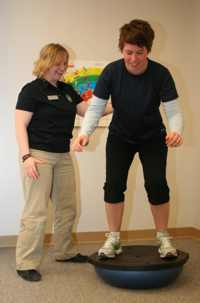

Before You Start > Keys to Success > Individual Level: What Do Employees Know, Believe and Do?
 This section talks about personal factors, such as starting fitness level, skills, knowledge and confidence.
This section talks about personal factors, such as starting fitness level, skills, knowledge and confidence.
Employees need to know:
-
Why physical activity is important?
-
How much they need to do?
Employees need to believe:
-
Being active is worthwhile.
-
They have enough skills to be active and stay active.
Employees also need to “do” their part! For instance, it’s vital that they set realistic goals. They also need to think about how to overcome common barriers, such as lack of time or energy.
Taking the First Step
The first step for an employer is to assess employees’ knowledge, attitudes and skills. Survey your staff or check in with them to get answers to key questions, such as:
-
Do employees believe that they should be active?
-
Do they want to be active?
-
Do they feel able to be active?
-
Do they know how to get started and how much to do?
By communicating with your employees, you will learn what they know and what physical activity they do now. Later on, after people have participated in your initiative, you can reassess your employees’ views and also track improved attitudes, knowledge and confidence in the ability to be active.
Sharing Information and Promoting Physical Activity
Be sure to provide information through the company intranet, newsletters, notice boards, “lunch and learn” sessions or courses, and other methods. Involve key staff members or departments (such as Human Resources or Communications) in getting the word out.
When employees can learn more about an activity and practice their skills, they feel more confident in their ability to do that activity and are more likely to do it. This even applies to something as simple as walking. Employees can learn how to dress for the weather, what to look for when buying walking or running shoes, and which muscles to warm up and stretch.
When employees can learn more about an activity and practise the skills, they feel more confident in their ability to do that activity and are more likely to do it.
Tips to Help Employees Set SMART Goals
Take time to make a plan and set smaller goals on the way to a more general goal. You’re more likely to see success with a SMART activity plan that includes goals with the following characteristics:
-
Specific: Clearly spell out what you will do, where, when and how.
-
Measurable: Choose something to track that will prove you have met your goal.
-
Attainable: Set a goal that requires effort but is within reach. Achieving short-term goals will keep you motivated as you work toward the long-term goal.
-
Realistic: Make it doable. Set goals that aren’t too easy or too hard.
-
Timely: Put an end point on your goal that gives you a clear target to work toward.
Here is an example of a SMART goal. “I will walk with Margaret and Kathy during lunch break, for 25 minutes, three days per week for the next eight weeks.”
For physical activity ideas tailored to individual employees, see the Ideas section on this website.
Find out More
The Canadian Physical Activity Guidelines (CPAG): The Guidelines explain why physical activity is important and how much activity you need to gain health benefits. You can order pads of one-page tear sheets summarizing the Guidelines or order a Handbook that include the Guidelines as a centrefold.
Healthy U: Employees can subscribe to weekly e-mail tips for healthy eating and active living. You can also reprint articles such as those in the list below for non-commercial purposes: